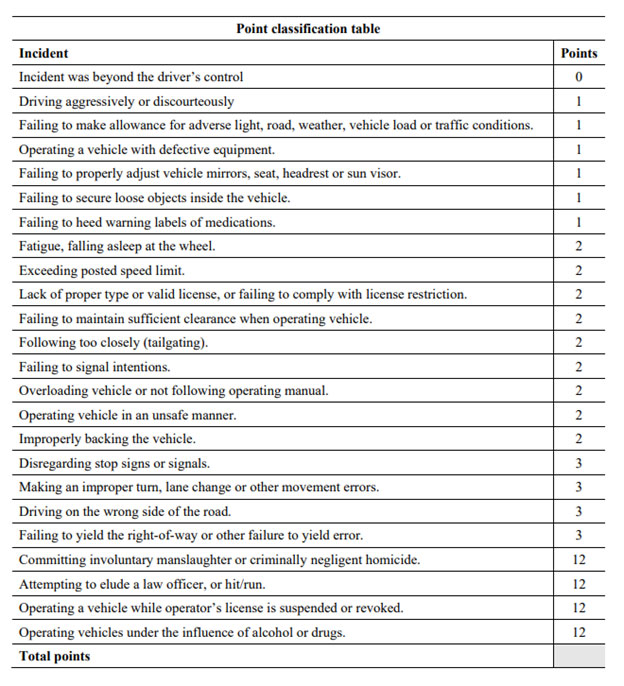Help Improve Driver Safety Through a Vehicle Accident Review Program

Whether your organization has non-commercial vehicles and/or commercial vehicles, a review of vehicle accidents is crucial to maintaining safe driver behaviors. An effective vehicle accident review program can help establish accountability for drivers who engage in risky driving practices. This is accomplished by discouraging repeated unsafe driving behaviors through:
- Vehicle accident reporting and review;
- Driver coaching;
- Driver retraining; and
- Change in employment status.
Managing Driver Behavior
Regardless of the amount of training provided, the number of road tests conducted, or motor vehicle records completed, tracking and effective management of driver behavior are required to complete any vehicle safety program.
Since drivers cannot be observed 100% of the time, managing driver behaviors can be difficult. Technological developments such as vehicle telematics, vehicle cameras, and collision avoidance systems are making this task easier. However, your organization must implement behavior management practices to help make these controls effective.
Addressing vehicle accidents is not much different when establishing the requirements for behavior management. Despite our best efforts, vehicle accidents continue to occur. While technological advancements attempt to proactively address vehicle accidents before they occur, vehicle accident reviews are the reactive approach to managing driver behavior after an accident occurs. Both approaches can be important in their own ways, but neither is as effective if action is not taken in response to the information it provides.
Your organization must establish effective ways to manage driver behaviors on an ongoing basis by analyzing data received from current sources and promptly addressing poor behaviors.
Vehicle Accident Reporting and Review
Your organization should implement a vehicle accident reporting policy, as well as a procedure for reporting and reviewing all vehicle accidents that involve your organization’s drivers. This includes drivers that are driving vehicles owned by your organization in addition to vehicles that are personally owned by the drivers. See the loss control article on Negligent Entrustment to learn more about why the use of personal vehicles matters to your organization.
Your organizational vehicle reporting policies/procedures should accomplish the following:
- Establish a company-approved vehicle accident report form.
- Establish specific requirements for vehicle accident reporting such as:
- Specific steps for your drivers to take after an accident;
- A process for how to conduct a vehicle accident investigation;
- An individual assigned to conduct vehicle accident investigations;
- An individual assigned to complete the vehicle accident report form;
- Specific steps for how to remove vehicles from the accident scene;
- All required notifications to make after an accident and when they should be made; and
- Other considerations such as post-accident breath alcohol and drug testing.
Click here for a sample vehicle accident report form.
Screening Employees Who Have Poor Driving Records
A vehicle accident review committee should review the vehicle accident report to determine whether the vehicle accident was preventable or non-preventable. Preventable accidents should be assigned points. Your organization should establish a point system to screen employees who have poor driving records. Below is a sample matrix:
- 3-5 points: Employee receives a letter of reprimand.
- 6-8 points: Employee receives a letter of reprimand, a one-day suspension without pay, and the employee must complete a driver improvement course.
- 9-11 points: Employee receives a letter of reprimand, a two-day suspension without pay, and the employee must complete a driver improvement course.
- 12 or more points: Employee is either reassigned to a non-driving position if available, or if a non-driving position is not available, the driver should be terminated.
Before reinstatement to a driving position, the driver should be required to complete a driver improvement course. Drivers who have six or more points in 36 months should complete a driver improvement course within 60 days of notification by the appropriate manager and provide a written certificate of completion to the vehicle accident review committee.
Points for preventable vehicle incidents and violations should be determined from a point classification table such as this one:

Re-qualification For Drivers Who Have Poor Driving Records
Your organization should establish a procedure for returning drivers to driving positions after they have completed a driver improvement course. Below is a sample procedure:
Drivers who have been reassigned to non-driving positions for poor driving records may re-qualify after six months under the following conditions:
- Drivers must send a written request to the appropriate manager stating why they should be re-qualified. Re-qualification requires the appropriate manager’s approval.
- Drivers must also complete a driver improvement class, which may include remedial and behind-the-wheel training before resuming their driving duties.
For additional Loss Control guidance, please visit the Plan & Protect safety hub.














